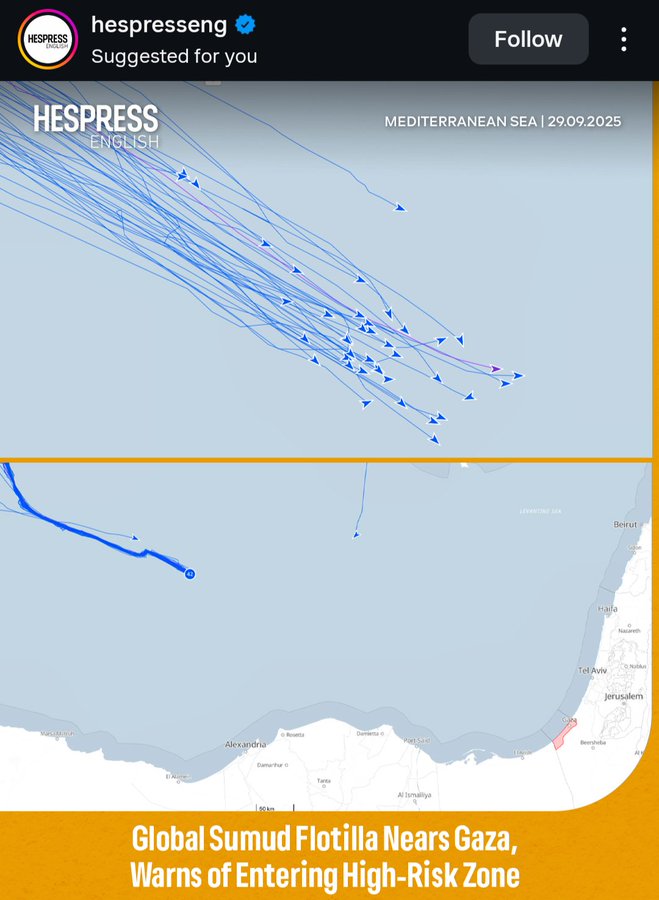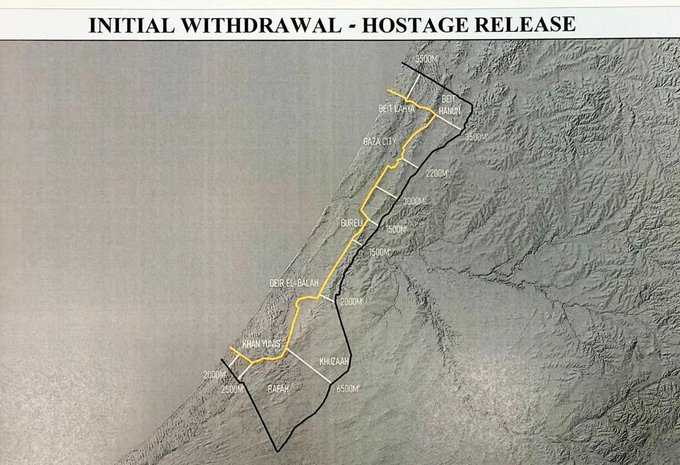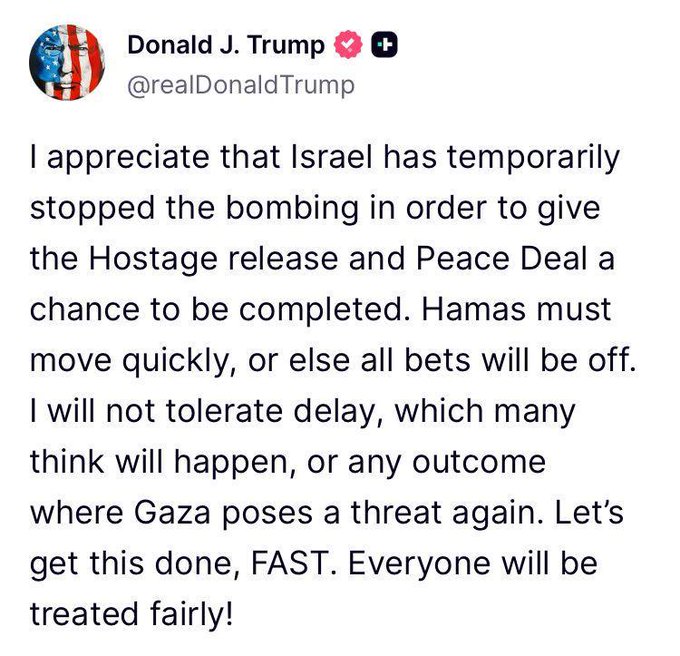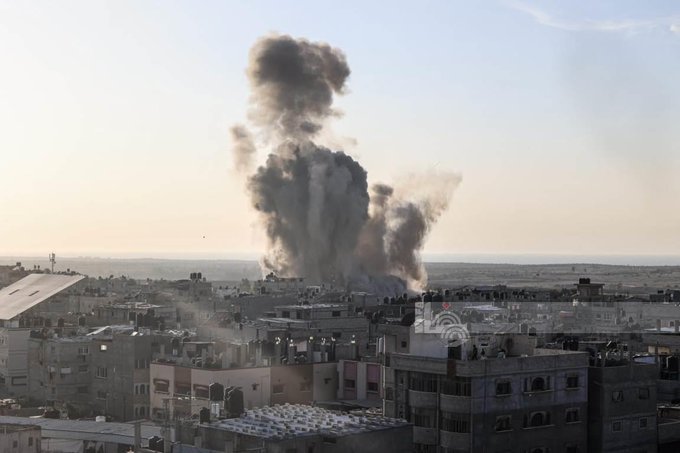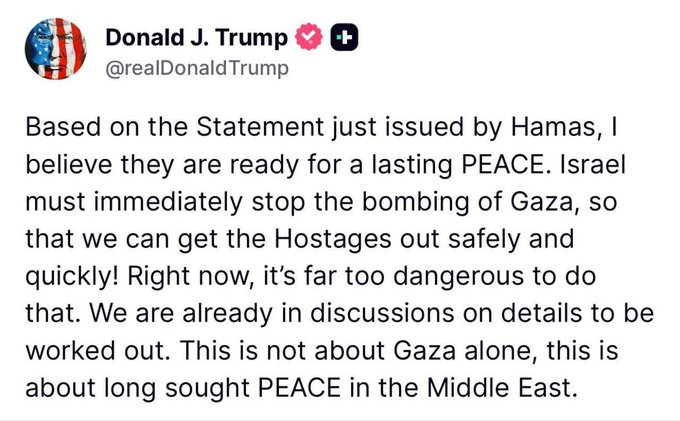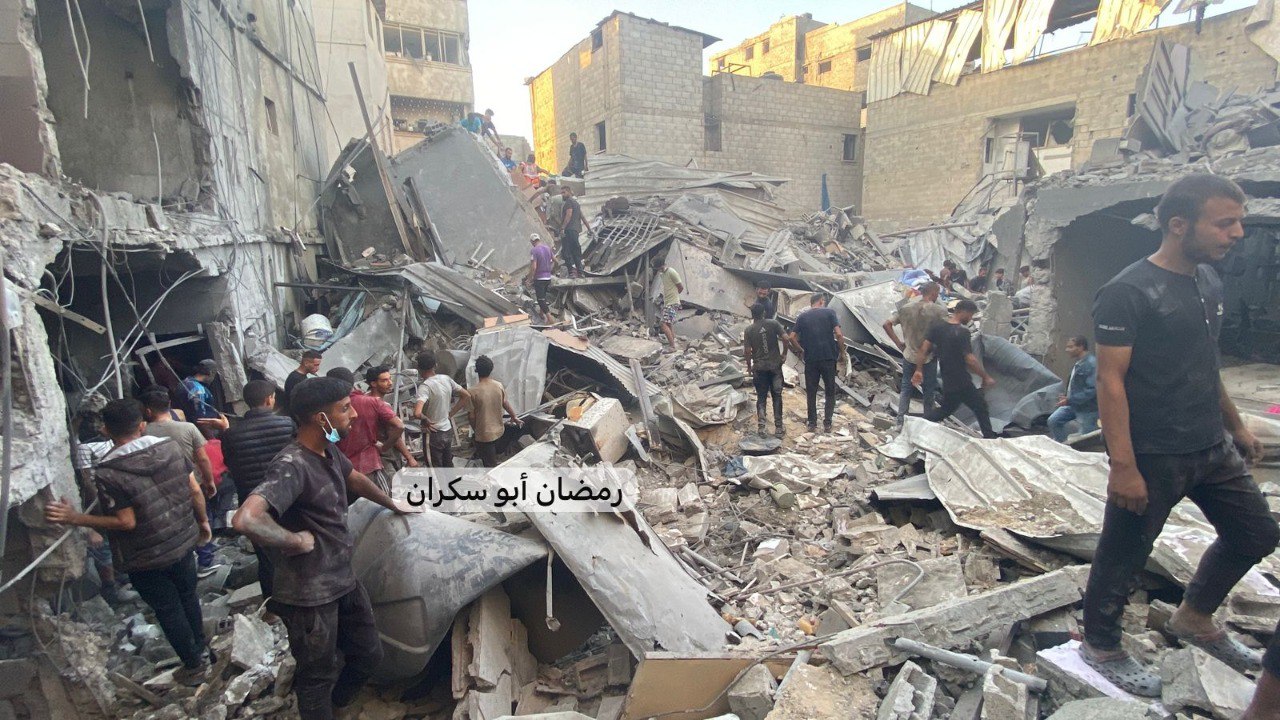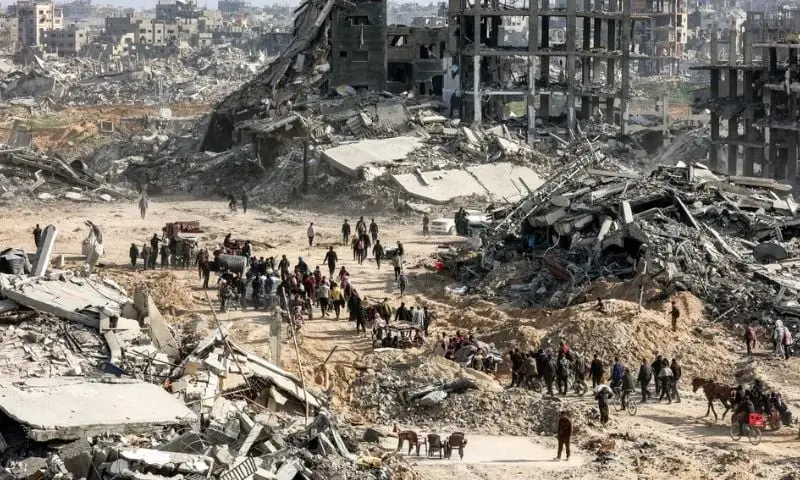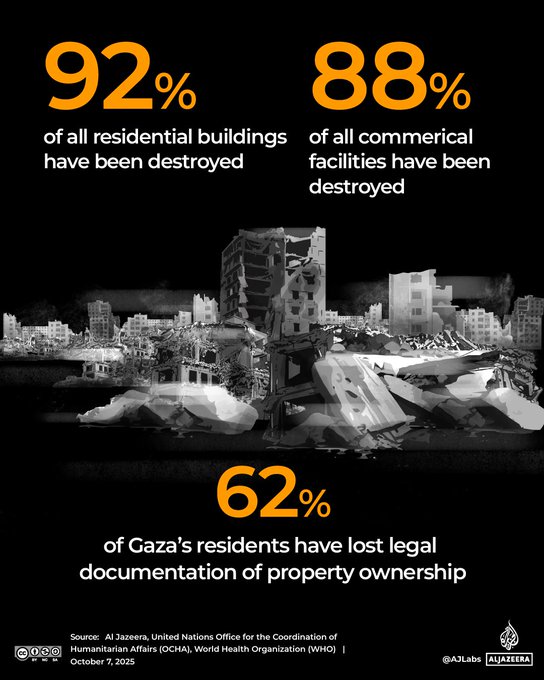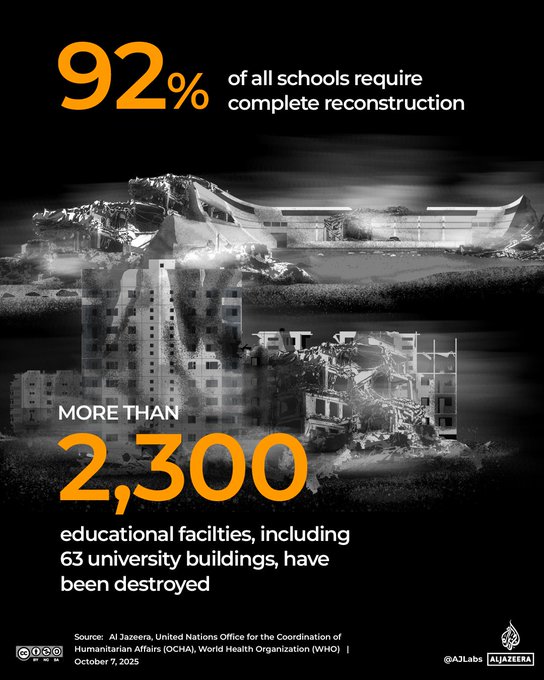Israel Is Committing Genocide in the Gaza Strip: The Fortieth Newsletter (2025)
7 October 2025 will mark the second anniversary of Israel’s ongoing genocide in Gaza. At least 66,000 Palestinians have been killed in Gaza during this time – 30 out of every 1,000 people.
2 October 2025

Sliman Mansour (Palestine), The Sea Is Mine, 2016.
Dear friends,
Greetings from the desk of Tricontinental: Institute for Social Research.
7 October 2025 will mark the second anniversary of Israel’s ongoing genocide in Gaza. The World Health Organisation’s data page on Palestinian casualties, regularly updated using figures from the Palestinian Health Ministry and UN agencies, shows that around 66,000 Palestinians have been killed in Gaza over the last two years – 30 out of every 1,000 people who were living in Gaza (these numbers, however may be too low, as the ministry has often admitted that it has no capacity to keep up with the flow of death and does not know how many people are buried beneath the tonnes of rubble).
The UN children’s agency, UNICEF, calculates that 50,000 Palestinian children have been killed or injured. As Edouard Beigbeder, UNICEF’s regional director for the Middle East and North Africa and a twenty-year veteran at UNICEF, stated:
These children – lives that should never be reduced to numbers – are now part of a long, harrowing list of unimaginable horrors: the grave violations against children, the blockade of aid, the starvation, the constant forced displacement, and the destruction of hospitals, water systems, schools, and homes. In essence, the destruction of life itself in the Gaza Strip.
Beigbeder’s statement was based on an assessment of the facts over the last two years. Indeed, the year before, Commissioner General of the UN’s Palestine agency (UNRWA) Philippe Lazzarini said that every day, ten children lost one or both legs due to Israel’s bombardment. A few months later, Lisa Doughten of the UN’s Office for the Coordination of Humanitarian Affairs told the UN Security Council that ‘Gaza is home to the largest cohort of child amputees in modern history’. These stories received little to no attention in mainstream media outlets.

Halima Aziz (Palestine), Motherland, 2023.
On 16 September, the UN Independent International Commission of Inquiry on the Occupied Palestinian Territory published a seventy-two page report packed with facts that concluded ‘on reasonable grounds’ that the Israeli government, its high officials, and the military had committed and are continuing to commit acts (actus reus) of genocide with the intention of committing these acts (mens rea). This judgment is far more encompassing than the International Court of Justice’s January 2025 finding of ‘plausible’ evidence of genocide. The commission is led by Navi Pillay, a former judge on the South African High Court and at the International Criminal Court who served as UN high commissioner for human rights from 2008 to 2014. She was clear and direct in her press statement following the release of the report: ‘The Commission finds that Israel is responsible for the commission of genocide in Gaza. It is clear that there is an intent to destroy the Palestinians in Gaza through acts that meet the criteria set forth in the Genocide Convention’.
There is no need to argue the case further. These are the strongest words possible.

Mohammed Al-Hawajri (Palestine), Maryam, 2015.
In mid-September, I visited Palestinian refugee camps in Lebanon, where the mood oscillates between despondency and resilience. At least four generations of Palestinians live in three of Lebanon’s largest Palestinian camps: Ain al-Hilweh, established in Saida in 1948 by the International Committee of the Red Cross or ICRC; Shatila, established in Beirut in 1949 by the ICRC; and Mar Elias, established in Beirut in 1952 by the Congregation of St. Elias.
The Nakba (Catastrophe) generation, who came as children or young adults mostly from what is now northern Israel into Lebanon in 1948.
The second generation of Palestinian refugees, the first to be born in the camps. They formed the core of the armed resistance as the fedayeen (fighters) through various new Palestinian political organisations such as Fatah (founded in 1957), the Palestinian Liberation Organisation (founded in 1964), and the Popular Front for the Liberation of Palestine (founded in 1967).
The third generation, born in the 1970s and 1980s, who came of age during the Israeli occupation of Lebanon (1982–2000) and had their political teeth cut in the first Intifada (1987–1993) and the second Intifada (2000–2005). Many of them drifted from the organisations of the previous generation and went into the Palestinian Islamic Jihad (founded in 1981) and Hamas (founded in 1987).
The fourth generation, born in the 1990s and after, who grew up at a time of shrinking opportunities in the camps and with a growing sense of futility and anger.
Four generations have lived in these camps, far from their homes in Palestine, since 1948. They look south and wonder when they will be able to exercise their right to return, a right that was guaranteed in UN Resolution 194 in December 1948.
Whether in the West Bank, Jordan, or Lebanon, the sense of absolute anger and hopelessness in the camps is overwhelming. The Palestinians who live there watch the images coming from Gaza, the absolute destruction and unrelenting genocide. It feels as if they can do nothing. The urge to pick up the gun and fight to defend the people of Gaza is overwhelming but impossible. They feel taunted by the Israelis, whose cold-blooded murder of Palestinian children takes anger to the boiling point. A few of these young people took me aside at Shatila and showed me a viral video of a Chinese professor, Dr. Yan Xuetong of Tsinghua University, arguing with an Israeli military representative, Colonel Elad Shoshan, at the Xiangshan Forum in Beijing in September 2025.

Chinese scholar clashes with Israeli commander in September 2025.
When Colonel Shoshan tried to defend the genocide, Dr. Yan interrupted and said ‘your government has no legitimacy [or] the right to decide or define what is fact’. Dr. Yan cut off Shoshan’s mumbles about terrorism with the direct statement that there is just ‘too much propaganda’, and ‘no one believes it except a few Israelis’. Dr. Yan’s anger pleased the young Palestinians, who saw their own feelings mirrored in his words and conviction. They have no time for splitting hairs. They want the violence to end and Palestine to be free.

Nabil Anani (Palestine), The Palestinian Icon, 2010.
Meanwhile, in Gaza City’s Midan al-Jundi al-Majhool (Square of the Unknown Soldier), the sound of music wafts through the air. Ahmed Abu Amsha, a music teacher at the Edward Said National Conservatory of Music who has been displaced at least twelve times during the genocide, gathers children to form a group called Gaza Birds Singing. Surrounded by the sounds of drones, they took their ambient buzz to build their own harmonies around – the sonic canvas of guitar and singing built around the drone.
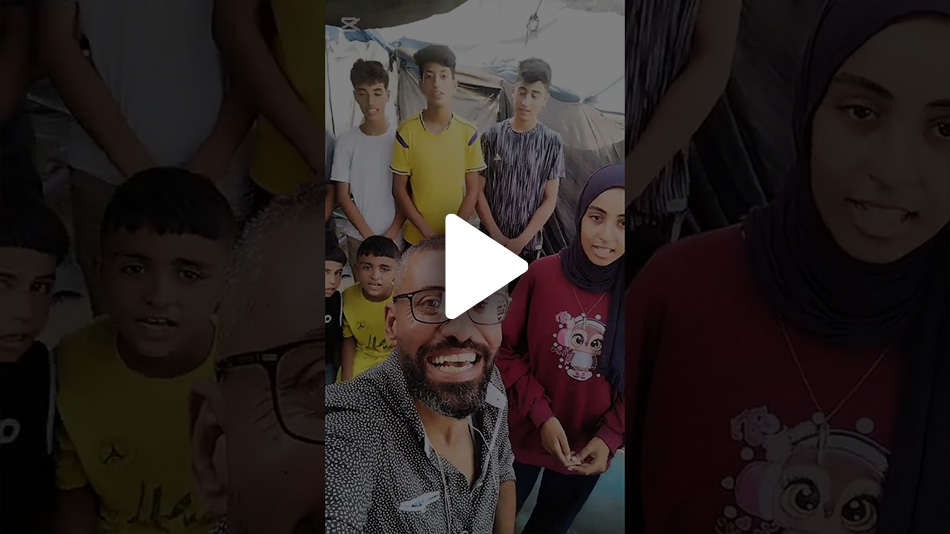
Gaza Birds Singing performs Sheel sheel ya Jamali to the sound of drones in August, 2025.
One of their most popular songs is Sheel sheel ya Jamali (Carry, Carry, O My Camel), a familiar Palestinian chant:
Carry, carry, O my camel,
Bear the load in God’s name.
The martyr’s blood is perfumed with cardamom,
O night, give way to dawn.
Woe, woe upon the tyrant,
God’s own judgment will fall.
No shadow can hide the stars of night –
I cry out for him.
We must bring down the tyrant.
Warmly,
Vijay
https://thetricontinental.org/newslette ... niversary/
******
Disarm Jerusalem, Not Gaza
Posted by Internationalist 360° on October 1, 2025
Rima Najjar
 This is what sovereignty looks like under a Jewish supremacist regime. Disarm Jerusalem, Not Gaza.
This is what sovereignty looks like under a Jewish supremacist regime. Disarm Jerusalem, Not Gaza.
From Corpus Separatum to Settler Sovereignty: A Case for Indictment
Author’s Note: This essay argues that disarmament must begin in Jerusalem — the epicenter of supremacist sovereignty and settler-colonial control — not in Gaza, which remains besieged and starved. It traces the betrayal of the 1947 corpus separatum designation, documents the ongoing erasure of Palestinian civic and cultural life, and indicts the international complicity that sustains it. The essay then outlines four modalities of resistance — armed, legal, international, and cultural — each refusing not only Trump’s plan, but the Jewish supremacist ideology that made it possible. What matters is not diplomatic tone or strategic optics. What matters is the ideological clarity of the rejection.
Opening: It isn’t Gaza that should be disarmed. It’s Jerusalem.
When Western powers — namely the United States, the United Kingdom, and France — through Zionist machinations first tried to impose the 1947 UN Partition Plan on Arab Palestine, Resolution 181 proposed dividing Palestine into separate Jewish and Arab states, with Jerusalem designated as a corpus separatum: a demilitarized city under international administration.
The plan was drafted not in consultation with Palestinians, but in defiance of their overwhelming rejection. It was engineered by colonial powers who had already failed to protect Jewish refugees in Europe and now sought to offload their moral debts onto Palestine. The architects — Harry S. Truman, Ernest Bevin, and Georges Bidault — must have had an inkling that Zionist exclusive sovereignty over Jerusalem would turn it into a flashpoint of settler-colonial expansion and Jewish supremacy. As it turned out, they were right.
After occupying East Jerusalem in 1967, Israel moved quickly to erase Palestinian political and civic presence. It dissolved the elected Palestinian municipal council, deported officials like Mayor Rawhi al-Khatib, and replaced local governance with Israeli administrative control.
And the takeover didn’t stop at bureaucracy.
Israel began systematically expelling Palestinian residents, revoking their residency rights under arbitrary criteria, and denying family reunification. Entire neighborhoods — Silwan, Sheikh Jarrah — were targeted for Jewish immigrant settler expansion, with homes demolished under the pretext of lacking permits Palestinians were never allowed to obtain.
This is not a closed chapter. It is ongoing. The complicity is not historical — it is active.
Israeli authorities erase municipal records from East Jerusalem’s city hall, confiscate keys at checkpoints, and deny recognition of Palestinian property deeds in court.
Israeli maps rename streets, erase neighborhoods, and redraw boundaries to fabricate permanence. But cartography is not sovereignty. It is a tool of it — and it can be refused.
The U.S. Embassy move to Jerusalem, the Abraham Accords, and the EU’s silence on residency revocations all signal endorsement.
Corporations like Caterpillar and Hyundai supply the machinery of demolition.
UNESCO’s designation of Jerusalem as “shared heritage” is undermined by its failure to protect Palestinian access.
Furthermore, Israel weaponizes access to holy sites: Muslim worshippers face military checkpoints and age restrictions at Al-Aqsa, while Christian Palestinians are routinely denied permits to visit holy sites in Bethlehem and Jerusalem. Surveillance, land confiscation, and settler violence are daily tools of control.
The goal is to Judaize Judaize the city, to erase its Palestinian character, and to make indigenous life untenable — going to the extreme of digging tunnels beneath Haram al-Sharif in pursuit of a mythical Jewish temple.
Jerusalem was meant to be protected from sovereignty — not subjected to its supremacist execution.
So, let us be clear.
If disarmament is to mean anything, it must begin with the city where the settler-colonial Jewish supremacist regime is headquartered.
If disarmament is to mean anything, it must begin with the city that was meant to be protected from Zionist sovereignty, not the one besieged and crushed by it.
Resistance Is Vital and It Continues in Many Forms
• Armed Resistance
Intensified not as escalation but as insistence: we will not be erased.
In Gaza, the Al-Qassam Brigades and Palestinian Islamic Jihad continued operations despite catastrophic losses, framing their actions as existential defense rather than tactical aggression. In Khan Yunis, new formations like the Counterterrorism Strike Force (CSF) emerged, declaring their intent to resist both Hamas repression and Israeli occupation.
Tribal militias such as those led by Husam al-Astal and Yasser Abu Shabab — though controversial — signaled a fracturing of control and a refusal to accept externally imposed governance models. The Resistance Committees, led by Ayman Al-Shishniya, rejected the Trump administration’s postwar plan as a “recycling of the Deal of the Century,” warning that international blessings for the plan amounted to complicity in genocide and ethnic cleansing.
• Legal and Diplomatic Resistance
Sharpened its indictments: naming genocide, naming apartheid, naming complicity.
In September 2025, the UN Independent International Commission of Inquiry concluded that Israel had committed genocide in Gaza, citing four of the five acts defined by the Genocide Convention — including deliberate starvation, destruction of infrastructure, and targeting of children.
Amnesty International echoed this, calling for an end to the “political economy enabling genocide,” and naming corporations complicit in the supply chain of destruction — from Boeing and Lockheed Martin to Elbit Systems and Palantir.
Legal scholars and human rights bodies convened in forums like the Jurists for Palestine webinar to explore peacekeeping mechanisms and civilian protection strategies, emphasizing the need for third-state accountability and international criminal prosecution.
• International Solidarity
Fractured and reformed, with students, workers, and artists declaring: we will not be neutral.
On September 22, 2025, nearly one million people across Italy staged a general strike in support of Palestine, shutting down ports, train stations, and major junctions under the slogan “Blocchiamo Tutto” (“Let’s block everything”).
In Berlin, artists projected images of Gaza’s destruction onto embassy walls, while in Beirut, refugee-led collectives organized teach-ins and cultural vigils.
Education International issued a global call for solidarity with Palestinian teachers and students, condemning the destruction of every higher education institution in Gaza and the killing of over 10,000 children.
And in the Mediterranean, the Global Sumud Flotilla — a civilian-led fleet of over 40 vessels carrying 500 activists from more than 40 countries — set sail to break Israel’s naval blockade of Gaza.
Despite drone attacks off the coast of Greece and aggressive interception by Israeli warships near Gaza’s exclusion zone, the flotilla pressed forward, broadcasting live footage and refusing to turn back.
Among those aboard were climate activist Greta Thunberg, South African MP Mandla Mandela, and French-Palestinian MEP Rima Hassan.
Their mission was not symbolic. It was juridical: to deliver humanitarian aid and to indict the blockade as a tool of starvation and siege.
“We sail on undeterred by Israeli threats and tactics of intimidation,” the flotilla declared.
“The humanitarian demand to break the blockade cannot be walked back to port.”
• Cultural Resistance
Surged — poets, illustrators, archivists, meme-makers — each refusing the terms of the plan by refusing its grammar.
Artists like Lina Abojaradeh used murals, comics, and poetry to evoke radical empathy and defiance, declaring that “art gives us a space to stop. To feel. To recognize the humanity in the people suffering.”
The deaths of cultural figures like Heba Abu Naha and Refaat Alareer — whose poem “If I Must Die” became a global rallying cry — marked not just personal loss but cultural devastation.
Visual artists such as Sliman Mansour and Abdul Hay Mosallam Zarara continued to be cited as foundational voices in the aesthetics of resistance, their works circulating in protests, classrooms, and digital archives.
Among the most incisive voices in cultural resistance is Palestinian cartoonist Mohammad Sabaaneh, whose stark black-and-white illustrations refuse euphemism and demand indictment. His work refuses to normalize ethnic cleansing.
What Matters Is the Ideological Clarity of the Rejection of Trump’s Plan
We should not have been shocked at Trump’s plan, but we were — because even those of us who have spent decades witnessing and recording Israel’s ethnic cleansing of Palestinians — of annexation, of demographic engineering, of mass incarcerations, of checkpoints, of house demolitions, of land confiscation, of settler rapaciousness — still feel the sting when the mask slips entirely.
Our grief is the grief of recognition.
The ache of seeing what we already witnessed and knew, now stripped of pretense and doublespeak — the genocide in Gaza, the mass displacement, the starvation, the targeting of journalists, hospitals, schools, cemeteries.
Trump’s plan is a declaration that the machinery of erasure no longer requires euphemism.
And so, after the shock and grief, we mobilized again to reject. To refuse. To clarify.
From Gaza, from the camps, from the diaspora, from the streets of Ramallah and the refugee corridors of Berlin and Beirut, came a chorus — not of surprise, but of refusal.
https://libya360.wordpress.com/2025/10/ ... -not-gaza/
*****
Israeli Forces Spark Global Outrage by Intercepting Sumud Flotilla Off Gaza Coast
Posted on October 2, 2025 by Yves Smith
Yves here. This article gives some insight into the stat of play with the Israel boarding of ships in the Sumud Gaza relief effort, but is light on what happens next. Israel says the individuals they captured will be prosecuted in Israeli courts. At a minimum, that means beaten up in Israel gaols. They are being accused of being Hamas collaborators and can be expected to receive the sort of rough handling that has been repeatedly decried by human rights group. For instance, from the BBC in Blindfolded, bound and beaten: Palestinians tell of Israeli jail abuse:
Israel’s leading human rights organisation says conditions inside Israeli prisons holding Palestinian detainees amount to torture.
B’tselem’s report entitled “Welcome to Hell”, contains testimony from 55 recently released Palestinian detainees, whose graphic testimony points to a dramatic worsening of conditions inside prisons since the start of the Gaza war 10 months ago.
It’s the latest in a series of reports, including one last week by the UN, which contain shocking allegations of abuse directed against Palestinian prisoners.
B’tselem says the testimony their researchers have gathered is remarkably consistent.
“All of them again and again, told us the same thing,” says Yuli Novak, B’tselem’s executive director.
“Ongoing abuse, daily violence, physical violence and mental violence, humiliation, sleep deprivation, people are starved.”
The mere interception of these ships is sparking protests in Europe. When word gets out of abuse of citizens of these countries, expect the BDS movement and port worker embargoes on loading and servicing vessels going to and from Israel to increase greatly.
Conor had warned that Meloni was facing a public revolt if she (as expected) capitulated to US pressure and pulled by the Italian navy vessel that had been one of the escorts of the Sumud flotilla.
 Italy is on the verge of a general strike.
Italy is on the verge of a general strike.
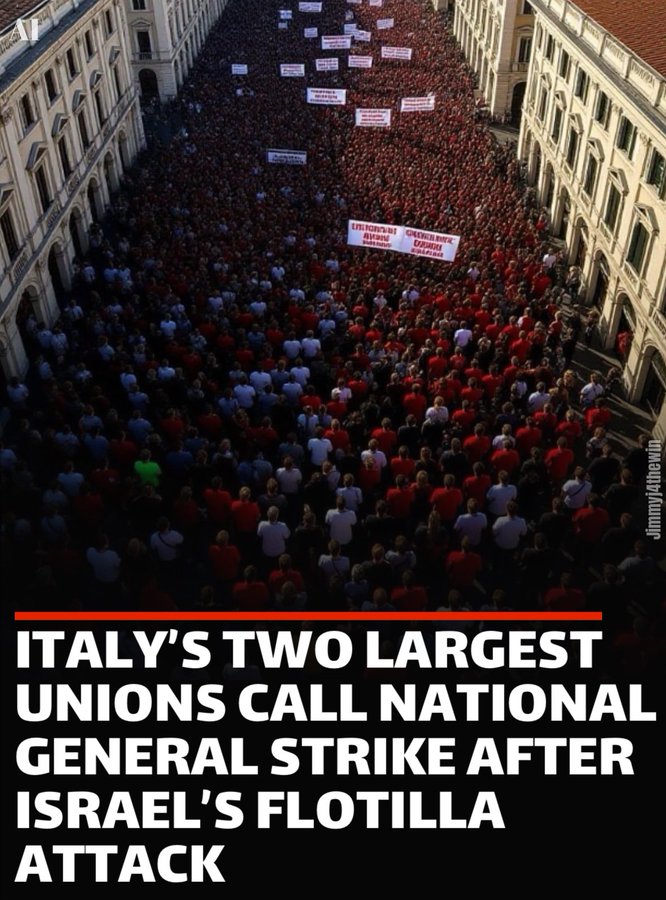
— 𝓙𝓲𝓶𝓶𝔂 𝓙 🫒
 (@JimmyJ4thewin) October 1, 2025
Italy's largest union, with over 5.5 million workers, has called a general strike for Friday in solidarity with the Global Sumud Flotilla.
(@JimmyJ4thewin) October 1, 2025
Italy's largest union, with over 5.5 million workers, has called a general strike for Friday in solidarity with the Global Sumud Flotilla.
And smaller Italian unions have said they will join CGIL's general strike.
— More Perfect Union (@MorePerfectUS) October 1, 2025
And fresh from DJG, Reality Czar:
Herebelow, I attach a screen shot from the latest e-blast from Arci (the association founded by the commies that is an umbrella for associations, cultural institutions, leisure activities, and student groups). The Karma is the boat sponsored by Arci.
Here in Torino, there already were demonstrations last night. I received a notice of a demo for 18,00 (6:00 p.m.) today, and I will try to get to the Piazza Castello to check on it.
Tomorrow, the CGIL, the main union (also founded by commies!) has called for people to muster at 9:00 a.m. There are other demos called for 1:00 p.m. and 6:00 p.m.
More info later, as things develop.
And as Conor Gallagher undoubtedly knows, being so astute about Italy, poor little Giorgia Meloni has already made some self-defeating, self-pitying statements. Not that such rhetorical slop has much effect — either way — these days.
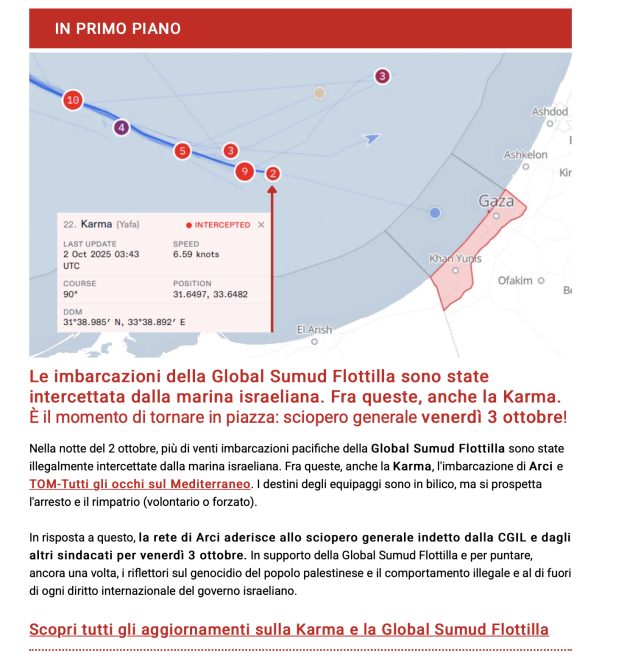 By Stephen Prager and Jessica Corbett, staff writers at Common Dreams. Originally published at Common Dreams
By Stephen Prager and Jessica Corbett, staff writers at Common Dreams. Originally published at Common Dreams
This is a developing story… Please check back for updates…
Israel intercepted multiple boats from the Global Sumud Flotilla seeking to bring humanitarian aid to the Gaza Strip late Wednesday, generating outrage and displays of solidarity from across the globe.
“History will side with the flotilla,” said former UK Labour Party Leader Jeremy Corbyn, who remains in Parliament. “And their bravery will only inspire more people to join our global movement for Palestine.”
Turkey’s foreign ministry described the interception as a “terrorist act… which targeted civilians acting peacefully,” while Colombian President Gustavo Petro booted the entire Israeli diplomatic delegation from his country immediately following the news.
In Barcelona, hundreds of outraged protesters gathered outside the Israeli consulate. Similar scenes broke out in other cities around the world, including Istanbul and Brussels.
BREAKING: Massive demonstration in Brussels this evening in defense of the Global Sumud Flotilla, which has begun to be intercepted by Israeli boats
After Place Bourse, the demonstration is heading towards the Ministry of Foreign Affairs. pic.twitter.com/uEzDfLsYz6
— Muhammad Yasir (@YasirHajana) October 1, 2025
The Guardian reported that the Israel Defense Forces (IDF) boarded at least two vessels roughly 75 miles away from Gaza. A livestream from the flotilla showed signals from boat after boat going dark after the convoy was surrounded by over 20 Israeli naval ships.
According to Drop Site News—whose editor Alex Colston has been reporting from one of the vessels—by midnight local time, at least six boats from the flotilla had been intercepted and boarded by the IDF.
After midnight, one sailor shared on the livestream that Israeli ships were spraying the flotilla boats with water cannons. By 1:00 am, the stream only showed the Meteque, where sailors held their hands above their heads as the IDF ordered them to stop their engine.
Sailors on the Meteque, a boat with the Global Sumud Flotilla, held their hands above their heads as Israeli forces ordered them to stop their engine off the Gaza coast at around 1:00 am local time on October 2, 2025. (Photo: screenshot/Global Sumud Flotilla/YoutTube)
An earlier video from flotilla activists shows the moment that Brazilian organizer Thiago Ávila received a message from an IDF soldier who ordered the flotilla to turn around.
“You are entering an active war zone,” the soldier is heard saying over an intercom. “If you attempt to breach the naval blockade, we will stop your vessel and act to confiscate it through legal proceedings in court.”
In response, Ávila pointed to the International Court of Justice’s provisional measures on Gaza and the International Criminal Court’s arrest warrant for Israeli Prime Minister Benjamin Netanyahu. Ávila asked Israeli forces to “stand down,” “not commit another war crime,” and “not engage with our peaceful, nonviolent, humanitarian solidarity mission for the Palestinian people in Gaza.”
Thiago Avila, member of the Global Sumud Flotilla, puts an IOF soldier in their spot as they tell them to turn around pic.twitter.com/RFG1aZW5XU
— Global Sumud Flotilla Commentary (@GlobalSumudF) October 1, 2025
In a courageous display, participants of the Global Sumud Flotilla chants in support of Palestine in defiance of the Israeli naval ships. pic.twitter.com/43CC1NmCun
— Fadi Daoud (@fjadaoud) October 1, 2025
The flotilla’s more than 40 civilian boats are carrying hundreds of humanitarians, journalists, and other noteworthy figures from dozens of countries around the world. They include the late South African President Nelson Mandela’s grandson, Mandla Mandela; American actress Susan Sarandon; former Barcelona Mayor Ada Colau; and multiple other European politicians.
Another video shows one of the flotilla’s most famous participants, 22-year-old Swedish climate activist Greta Thunberg, being detained by an IDF soldier.
The Israeli Navy has arrested Greta Thunberg aboard the Sumud aid flotilla. pic.twitter.com/kkwYcpgGw9
— Séamus Malekafzali (@Seamus_Malek) October 1, 2025
The flotilla set sail from Barcelona a few weeks ago, in response to Israel’s illegal near-total blockade of humanitarian aid entering Gaza, which has resulted in mass starvation. A group of United Nations experts warned in early September that any attempt by Israel to stop the vessels from delivering aid “would constitute a grave violation of international law and humanitarian principles.”
Throughout their journey toward Gaza, the flotilla members have faced numerous threats from the Israeli government, which has attempted to smear the humanitarian mission as an effort to advance the agenda of Hamas.
Last week, while still off the coast of Greece, the flotilla was swarmed with drones and attacked with flash-bang grenades believed to have been launched by Israel, which has a history of targeting such missions. That attack initially led the governments of Italy and Spain to send naval ships to offer protection to the flotilla, but they have since turned back as the boats moved closer to Gaza.
Israel’s actions against the Global Sumud Flotilla follow its interception of multiple Gaza-bound Freedom Flotilla Coalition boats earlier this year. Edward Ahmed Mitchell, deputy executive director of the Council on American-Islamic Relations, said Wednesday that “once again, the Israeli occupation has demonstrated that it will kidnap humanitarian activists and engage in piracy in international waters, all to maintain its lawless blockade of the Palestinian people.”
“Every nation that pays lip service to international law should condemn this illegal attack on the Global Sumud Flotilla and take their own steps to forcibly break the siege of Gaza,” he argued. “In the case of Western nations that continue to enable Israel’s genocide even as their own citizens risk life and limb to stop it, anti-Palestinian racism and the influence of anti-Palestinian lobby groups clearly explains their ongoing complicity.”
“We applaud the participants in the flotilla for their courage,” he added, “we demand their immediate release, and we urge the international community, including Western, Arab, and Muslim nations, to take action against the Israeli occupation for its crimes.“”
https://www.nakedcapitalism.com/2025/10 ... coast.html
*****
‘Stunning Reversal’: NYT Poll Finds Sinking US Support for Israel
September 30, 2025
A survey of 1,313 registered voters found that for the first time more respondents said they support Palestinians than Israelis, reports Julia Conley.

Child and others wounded in Israeli attack on Gaza, 2023. (Fars photo, Ghassan Salem, CC BY 4.0)
By Julia Conley
Common Dreams
As Israel’s bombardment of Gaza and starvation policy in the exclave nears the beginning of its third year, the assault that has killed more than 66,000 Palestinians has driven U.S. support for Israel “off a cliff,” suggested one commentator in response to a poll released by The New York Times and Siena College.
The survey of 1,313 registered voters found that for the first time since the newspaper and university have polled Americans on their sympathies regarding the Israeli-Palestinian conflict since 1998, more respondents said they support Palestinians than Israelis.
“The survey of 1,313 registered voters found that for the first time … more respondents said they support Palestinians than Israelis.”
Thirty-five percent expressed sympathy with the Palestinian side, while 34 percent said they support Israelis and 31 percent said they were unsure or had equal sympathy for both sides.
The poll did not show a majority of respondents backing Palestinians, who have demanded the right to self-determination and an end to Israel’s occupation and apartheid policies since Zionist forces ethnically cleansed hundreds of Palestinian towns and cities, killed 15,000 people, and expelled at least 750,000 Palestinians from their homes in order to establish the Jewish-majority state of Israel in the 1940s.
But the shift in support toward Palestinians was still viewed as seismic among political observers including journalist Krystal Ball, who said the poll showed that “Israel has lost the American people.”
Support for Israel and the United States’ policy of providing the country with more than $300 billion in aid — mostly military aid — since its founding have long appeared unbreakable among lawmakers from both major political parties, and the public has followed suit for decades.
In 2011, a Gallup poll found that U.S. adults were more than four times as likely to express sympathy and support for Israelis than for Palestinians. Between 1988 and 2011, the survey never found more than 20 percent of Americans siding with Palestinians.
The Times/Siena poll has found similar results, with 47 percent of respondents telling survey-takers that they supported Israel in the aftermath of the Hamas-led attacks on Oct. 7, 2023, and just 20 percent expressing sympathy with Palestinians.

End Aid to Israel demonstration in Washington on Nov. 4, 2023, during the Israeli assault on Gaza. (Consortium News)
In December 2023, only 22 percent of Americans told the Times and Siena they believed Israel was intentionally killing Palestinian civilians — despite numerous statements by Israeli officials suggesting that their policy was to do so.
In the first weeks of the war, then-Israeli Defense Minister Yoav Gallant said the government as cutting off deliveries of water, food, and fuel to Gaza because Israel was “fighting human animals,” and President Isaac Herzog said Gaza’s population of more than 2 million Palestinians were all “responsible” for the Hamas attack, denying that there were civilians who were “not involved.”
Nearly two years later, Americans have changed their view, with 40 percent saying Israel is intentionally killing Palestinians. A quarter of respondents said Israel is doing enough to prevent civilian casualties, down from 30 percent in 2023, and 16 percent said Israel is unintentionally killing civilians, down from 21 percent.
“Americans have changed their view, with 40 percent saying Israel is intentionally killing Palestinians.”
The Times reported a “stunning reversal” in public opinion regarding the continuation of U.S. aid to Israel since October 2023. More than half of registered voters now oppose providing Israel with military and economic aid.
Opposition was the highest among voters under the age of 44; 62 percent of those aged 30-44 said the U.S. should stop funding Israel, while 68 percent of voters aged 18-29 said the same.
Last month, a Quinnipiac University survey showed similar results, with 60 percent of voters from across the political spectrum saying they opposed more military aid for Israel — the most significant opposition level recorded by the university since it first asked the question in November 2023.
The Times survey displayed “absolutely staggering public opinion polling on Israel’s collapse among young Americans,” said journalist Glenn Greenwald.
“More than half of registered voters now oppose providing Israel with military and economic aid.”
“Though this was utterly unthinkable even five years ago,” said Greenwald, “it’s now reflected in poll after poll, and is so entrenched it’s hard to imagine it can be reversed.”
The poll was released Monday as progressive commentator Hasan Piker said in a video posted on social media by Current Affairs that Democratic lawmakers must abandon the idea that supporting Israel is “pragmatic,” pointing out that New York City Democratic mayoral nominee Zohran Mamdani easily won the primary election in June after being outspoken in his criticism of Israel’s policies in the occupied Palestinian territories.
“It’s not an area that you will be punished for, no matter how fearful you are of corporate donors, no matter how fearful you are of lobbying interests,” said Piker. “The people will back you, as we have seen with the primary victory for Zohran.”
Continuing to support Israel is “not pragmatic,” he added. “It’s actually the opposite of pragmatism.”
https://consortiumnews.com/2025/09/30/s ... or-israel/
*****
Hamas slams Israeli interception of Global Sumud Flotilla as 'piracy, terrorism'
Israel has boarded nearly all of the flotilla’s 47 boats, and has detained hundreds of activists
News Desk
OCT 2, 2025

(Photo credit: AA)
Hamas slammed the Israeli military’s interception of the Global Sumud Flotilla, which is carrying aid for Gaza, in a statement released on 2 October.
The statement called the interception “a treacherous attack and a crime of piracy and maritime terrorism against civilians.”
“It is a barbaric assault targeting international solidarity activists who were on an urgent humanitarian mission to deliver emergency aid to our besieged people in the Gaza Strip, who have been subjected for two years to genocide and systematic starvation,” Hamas added.
It also saluted “the courage of the free activists” and called on the UN and international community to hold Israel “accountable.”
Israeli naval forces moved to intercept the flotilla overnight as the boats were approaching the besieged strip.
Around 40 of the flotilla’s 47 boats have been boarded by Israeli forces so far. Hundreds of activists have been detained, including Swedish activist Greta Thunburg – who was detained and deported during the interception of a previous aid boat earlier this year. “The passengers are safe and in good health,” the Israeli Foreign Ministry said on Thursday morning.
Already several vessels of the Hamas-Sumud flotilla have been safely stopped and their passengers are being transferred to an Israeli port.
Greta and her friends are safe and healthy. pic.twitter.com/PA1ezier9s
— Israel Foreign Ministry (@IsraelMFA) October 1, 2025
At least four boats are stuck at sea due to technical issues. Israel will either detain the activists on board or tow the boats to shore.
Irish activist Tadhg Hickey is among those who sailed to Gaza on the Sumud Flotilla, as well as French politician Marie Mesmeur and French-Palestinian European Parliament member Rima Hassan, who has also previously been detained for attempting to break the siege.
Overnight and this morning, the Israeli Navy continued to intercept the large flotilla attempting to break the Israeli maritime blockade on the Gaza Strip.
Forces of the Shayetet 13 naval commando unit have boarded around 40 of the Global Sumud Flotilla's 47 boats, detaining… pic.twitter.com/udlSUmeWXA
— Emanuel (Mannie) Fabian (@manniefabian) October 2, 2025
Spain announced on 2 October that it summoned its Israeli envoy in response to the interception, adding that 65 Spanish citizens were aboard the flotilla.
The Turkish Foreign Ministry called the interception “an act of terrorism that constitutes the most serious violation of international law and endangers the lives of innocent civilians.”
“We are very concerned about the situation with the Sumud Flotilla, we are in touch with the families of a number of British nationals involved,” the UK government said.
The Global Sumud Flotilla departed from Spain one month ago. As it got closer to Gaza on 1 October, Israeli warships harassed the flotilla in a bid to force it to change course. Last month, several of the flotilla's boats were subjected to drone attacks.
On 30 September, Tel Aviv accused the Global Sumud Flotilla of having ties to Hamas.
In a statement, the Israeli Foreign Ministry claimed troops found Hamas documents in Gaza which show a “direct link between the flotilla leaders and the Hamas terrorist organization.”
https://thecradle.co/articles/hamas-sla ... -terrorism
amas seeking 'international guarantees' for Gaza ceasefire amid Trump threats: Report
Israel's Defense Minister said it is the 'last opportunity' for Palestinians to flee Gaza City as the army's ethnic cleansing campaign intensifies
News Desk
OCT 1, 2025

(Photo credit: Reuters)
Hamas is examining the ceasefire plan proposed by US President Donald Trump and wishes to amend several points in it, AFP reported on 1 October, citing a Palestinian source close to the resistance movement.
Trump's 20-point plan calls for a ceasefire, the release of Israelis held captive within 72 hours in exchange for Palestinian prisoners and detainees, Hamas's disarmament, the deportation of the movement's leaders, and a gradual Israeli withdrawal from Gaza.
A Palestinian source close to the Hamas leadership stated that "no final decision" had been made and that "the movement will likely need two to three days," AFP wrote.
"Hamas wants to amend some of the items, such as the disarmament clause and the expulsion of Hamas," the source said.
Hamas is also asking for "international guarantees" for a complete Israeli withdrawal from the strip and guarantees that Israel would not violate a ceasefire.
Trump told reporters on Tuesday that Hamas had "about three or four days" to accept his 20-point Gaza plan, warning the resistance movement it would "pay in hell" if it refused.
Meanwhile, Defense Minister Israel Katz asserted Wednesday that the Israeli military is close to encircling Gaza City and that Palestinians have a "last opportunity" to flee their homes.
"This will tighten the encirclement around Gaza City and everyone leaving it to the south will be forced to pass through IDF checkpoints," said Katz in a press release.
"This is the last opportunity for Gaza residents who wish to do so to move south and leave Hamas terrorists isolated in Gaza City, in the face of IDF activity that continues with full force."
Civilians remaining in Gaza City will be considered "terrorists and supporters of terror," by invading Israeli forces, Katz confirmed.
Israel continues to kill dozens of civilians across Gaza daily. The enclave's civil defense agency said Israeli strikes killed at least 46 people on Wednesday, including 36 in Gaza City.
A strike on a school sheltering displaced Palestinian families killed eight people.
Fadel al-Jadba, 26, told AFP he would defy Katz's threats and remain in his home in Gaza City.
"We want a ceasefire at any cost because we are frustrated, exhausted, and find no one in the world standing with us," he told the French news agency.
https://thecradle.co/articles/hamas-see ... ats-report


